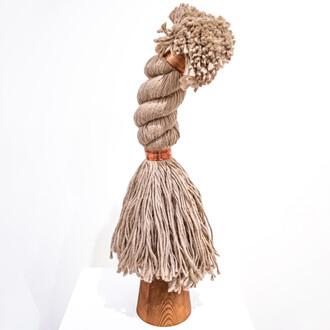Marlborough Contemporary is pleased to announce an exhibition of new works by German artist Werner Büttner. This will be Büttner’s first solo show at the gallery and his first major presentation in London since his seminal exhibition with Georg Herold and Albert Oehlen at the ICA in 1986. Together with Martin Kippenberger and Oehlen, Büttner has exerted a sustained and provocative impact on the European art scene since the late 1970s when, as the ‘Junge Wilde’, they sought to renounce the dominant modes of conceptual and minimal art through a return to painting. In 2013 Büttner was the subject of a major retrospective, Werner Büttner: Gemeine Wahrheiten [Common Truths], at ZKM, Karlsruhe, which travelled to the Weserburg Museum of Contemporary Art, Bremen in 2014. Hatje Cantz published a major monograph in conjunction with the exhibition.
Büttner creates surreal assemblages that question our systems of value and contradict our understanding of what elements or images may be brought together. His work confronts social norms with both irony and satire. While retaining a firm understanding of the history of painting, Büttner is constantly testing convention. In Die Markierung des Abgrunds (2012) which translates as The Marking of the Abyss, and lends the show its title, Büttner depicts a sublime German Romantic landscape. However in place of a rapturous onlooker, a dog engages with the scene by cocking its leg into the valley in a gesture of disregard.
In addition to nine large-scale paintings, the exhibition will feature a number of collages and C-prints. Büttner has worked with collage for the past 14 years, using the medium to create what he describes as something ‘crazy, unseen [and] unbelievable’. While he uses collage as the starting point for his paintings, they are not only preparatory studies but a strategy that enables juxtaposing realities and unexpected associations, which are characteristic of his extensive oeuvre.
Büttner was born in Jena in 1954 and in 1961 he moved from the DDR to Munich before the construction of the Berlin Wall. He returned to Berlin in 1968, where he studied Law at the Freie Universität Berlin, before becoming a social worker at the Berlin-Tegel Prison. In 1979 he exhibited at Kippenberger’s Büro as part of the renowned exhibition Elend, and in 1982 was part of the Martin-Gropius-Bau exhibition Zeitgeist, which was considered a definitive survey of painting at that time. He has been Professor of Painting at the University of Fine Arts of Hamburg since 1989.


![Werner Büttner, Profis betrachten einen Fanatiker... [Professionals Look at a Fanatic...], 2014.
Collage, 32 × 24 cm](http://media.meer.com/attachments/6d9da9ad612fd3e11d82d364a6e09c4d951d9ea4/store/fill/410/615/cd1ed572150068ba2bac98c497438e44c0e1471495629d5a1135c6d8162f/Werner-Buttner-Profis-betrachten-einen-Fanatiker-dot-dot-dot-Professionals-Look-at-a-Fanatic-dot.jpg)
![Werner Büttner, Denn es geht dem Menschen wie dem Vieh — manchmal wird’s halt preisgekrönt... [For that which Befalleth the Sons of Men Befalleth Beasts — Sometimes they are Prize-Winning...], 2013-2015, Pictor-print, 148 x 110 cm](http://media.meer.com/attachments/ca0d6b93ececb36e7e4fa2b9180bf4ff88d85ca3/store/fill/410/615/bde18bff7d377422145de4603655044ce65a3eda204ddd815101cfacc33e/Werner-Buttner-Denn-es-geht-dem-Menschen-wie-dem-Vieh-manchmal-wirds-halt-preisgekront-dot-dot.jpg)
![Werner Büttner, Reinigungskraft des Tempels [Cleaning-Force of the Temple], 2014,
Collage, 32 × 24 cm](http://media.meer.com/attachments/05b1242a53166acbab9a04d4a2a855bbf360c67b/store/fill/410/615/8e130effcefb451c6416e084d8b0ed02ca10333fd5955fb3a375437c57a8/Werner-Buttner-Reinigungskraft-des-Tempels-Cleaning-Force-of-the-Temple-2014-Collage-32-x-24-cm.jpg)
![Werner Büttner, Einsamkeit ist, verglichen mit allem, ein ziemlich bekömmlicher Zustand..., [Loneliness is, Compared to Everything, a Quite Digestible Condition...], 2013-2015, Pictor-print, 146 x 110 cm](http://media.meer.com/attachments/e336b217ad46ae7ca2d892e7620f5d8a0d76e120/store/fill/410/615/885b06459ff263fda8caee77f21e17bc9f19f7e7913f4bbb65676604cc37/Werner-Buttner-Einsamkeit-ist-verglichen-mit-allem-ein-ziemlich-bekommlicher-Zustand-dot-dot-dot.jpg)
![Werner Büttner, Der Vogel, der sah... [The Bird that Saw...], 2014, Collage, 32 × 24 cm](http://media.meer.com/attachments/9e3063d71785bf6a8275aa3614c61b377afbf0c7/store/fill/410/615/2d3c77091b52cdb2ffac8a2dd9ba0cc0e08b11ddf58bb46af4a8b8d8ff86/Werner-Buttner-Der-Vogel-der-sah-dot-dot-dot-The-Bird-that-Saw-dot-dot-dot-2014-Collage-32-x-24.jpg)
![Werner Büttner, Auch Biergarten in der Nähe..., [Even a Beer Garden Nearby...], 2013-2015, Pictor-print, 146 x 110 cm](http://media.meer.com/attachments/e53ef3d5483ce0da0fb9be2889a9223110b4c731/store/fill/410/615/01aa16b9b638b45d303f530e1a857cd57784d68c9ece1e7d5d75f5c8c6e0/Werner-Buttner-Auch-Biergarten-in-der-Nahe-dot-dot-dot-Even-a-Beer-Garden-Nearby-dot-dot-dot.jpg)











